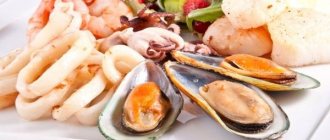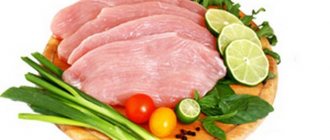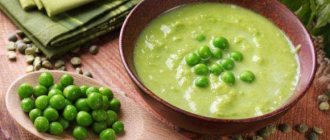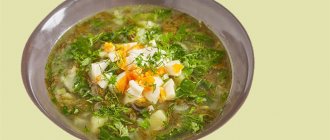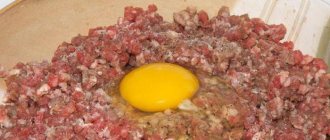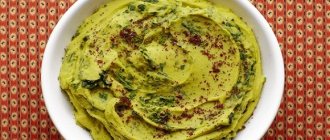The value of green peas for the body, chemical composition, calorie content and BJU
The nutritional value of green peas is calculated in the following indicators:
| Belkov | 5.4 g/100g |
| Zhirov | 0.4 g/100g |
| Carbohydrates | 14.5 g/100g |
| Calorie content | 81 kcal/100 g |
The benefits of peas are explained by the unique chemical composition.
Minerals (macro- and microelements in mg):
- calcium – 25;
- magnesium – 33;
- phosphorus – 108;
- potassium – 244;
- sodium – 5;
- iron – 1.5;
- zinc – 1.2.
Green peas contain a large amount of vitamins:
| Vitamins | |||
| Fat soluble (mcg/100g) | Water soluble (mg/100g) | ||
| A | 38 | WITH | 40 |
| beta carotene | 449 | IN 1 | 0.3 |
| alpha-carotene | 21 | AT 2 | 0.1 |
| TO | 24.8 | AT 3 | 2.1 |
| E | 0.1 | AT 4 | 28.5 |
| AT 5 | 0.1 | ||
| AT 6 | 0.2 | ||
| AT 9 | 65 | ||
In what form is it used?
In any form, peas prevent vitamin deficiency, prevent dermatological diseases and normalize metabolic processes.
This:
- Sprouted – sprouts are rich in insulin and enzymes that reduce blood glucose. When sprouting, the level of nutrients doubles. The kernels are filled with water and left for 4-5 days.
- Capsicum - is distinguished by its concentrated content of the vitamin and mineral complex, including folic acid. It is edible when young, while the skin is still soft and juicy.
- Canned - most common in cooking. Salads, soups, appetizers and salads are prepared from this type.
- Frozen – blast freezing allows you to preserve all the beneficial substances in the peas. With further defrosting and cooking, the kernels retain their shape and taste pleasant.
General information
Green peas are the fruits of peas, a herbaceous annual crop of the legume family, which have not reached a mature state.
Round grains of rich green color are located in a flat or convex pod of an elongated shape. They are very juicy with a sweetish taste and pleasant smell.
Consumption history
Man has been cultivating peas for a long time. Scientists have discovered its seeds in places where people lived since the Stone Age. The inhabitants of ancient China and India revered peas as a symbol of fertility and wealth.
The first written evidence of pea consumption dates back to the writings of the Greek philosopher Theophrastus in the 3rd century BC, which mentions planting them along with other legumes at the end of winter. For the ancient Romans, it was a natural element of the diet, included in the cookbook Apicius. In addition, local residents made rattles for their children by placing a pea inside a bull's bladder.
During the Middle Ages, pea grains became an important ingredient in the fight against hunger. Later they turned into a more luxurious dish, and for some regions of Europe they became a real delicacy.
The availability of canning technology, developed in the 19th century by the Dutch, allowed everyone to enjoy the taste and benefits of the green kernel. A hundred years later, the freezing process ensured an extended shelf life, increasing the popularity of this nutritious crop.
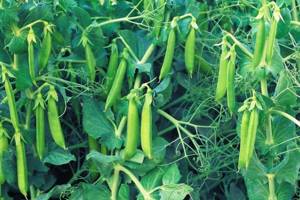
Benefits and harms
The rich vitamin composition allows you to replace medications for the prevention and treatment of serious diseases.

It has been proven that peas have the following effects on the body:
- Protein supply is replenished . Legumes are a source of plant proteins that are better absorbed than animal proteins.
- Hunger is satisfied . It is enough to eat 2-3 tbsp. l. grains for saturation, which turns out to be the prevention of overeating.
- The functioning of the circulatory system is stabilized. The effect is ensured by the presence of healthy fats in the composition.
- Blood pressure decreases . With systematic use, the development of hypertension is prevented.
- Skin condition improves . Vitamins provide filling of fine wrinkles, improve the color and contours of the face.
- Relief of hangover syndrome . Canned or young peas will improve the condition after a strong feast.
Despite the rich list of benefits, eating peas should not be taken lightly.
Negative consequences of use:
- Increased gas formation and flatulence . Excessive consumption increases the risk of bloating and colic.
- Allergic reactions . For the first time, children can be offered peas only in small quantities to prevent skin rashes and hypersensitivity.
- Disturbances in the gastrointestinal tract . Peas are hard food for the stomach. If abused, the pathological state of digestion may worsen. Most often, constipation and difficulty digesting food may occur.
During pregnancy and lactation
Green peas contain calcium. This improves the condition of the nail plates and hair. Iron maintains hemoglobin levels, and folic acid rejuvenates the skin, restores damaged cells and improves reproductive functions.
With moderate consumption, the expectant mother and child will only benefit from peas:
- assistance in the development of the child’s nervous and skeletal system;
- prevention of vitamin deficiency and anemia;
- satiation without weight gain;
- improved sleep and reduced irritability.

During breastfeeding, you cannot eat vegetables, since the baby’s digestive system is not fully formed, and symptoms such as abdominal pain, regurgitation, constipation, and diarrhea may occur.
For men
Peas easily and tasty restore strength after strength training, help build muscle mass and prevent diseases of the genitourinary system. Potency increases and the quality of sexual intercourse improves.
When losing weight
Green peas, whose calorie content is 80 kcal/100g, are considered a low-calorie product with a high content of protein and fiber. When losing weight, canned peas are also allowed, but they are not considered dietary, they only quickly satiate the body and dull the feeling of hunger. To reduce weight, peas are used as a side dish or a complete replacement for meat.
Important! For regular consumption of peas, you need to drink more pure water without gas, so as not to harm digestion.
For pancreatitis
For diseases of the pancreas, pancreatitis and cholecystitis, fresh and sprouted peas are allowed exclusively at the remission stage in small doses. Legumes prevent the formation of gallstones.
For diabetes
It is acceptable to consume peas for type 2 diabetes mellitus, since its glycemic index is 40. It is better to cook the vegetable at home rather than buy canned ones. Peas will slow down the absorption of glucose, block the breakdown of starch and stimulate the gastrointestinal tract.
For the elderly
Substances from peas inhibit the aging of all body systems, slow down hair loss and reduce the rate of wrinkles.

Protein helps restore the tone of flabby muscles, and vitamin K, magnesium and calcium reduce the risk of fractures . Only older people with limited mobility need to give up peas.
The benefits of peas for the body
When eaten, peas have undeniable beneficial properties for the body. They are as follows:
- Green peas are useful to eat for those who have problems with swelling of tissues and internal organs. The product removes fluid and salts from the kidneys.
- The benefit of peas for the body is to prevent the development of cancer.
- Sprouted beans have a beneficial effect on lowering cholesterol, removes toxins from the body, and normalizes heart function.
- The medicinal properties of peas lie in the fact that the product contains iodine. This substance treats the thyroid gland in case of its deficiency in the human body.
- Bob relieves eye fatigue and also prevents the development of cataracts and the symptoms of this unpleasant disease.
- Boiled beans are good to eat for people who have stomach problems, with the exception of intestinal flatulence or irritation.
- Bean stimulates the immune system, which is especially important during periods when there is an increase in the number of influenza and ARVI diseases.
- Increases a person’s performance by supplying his body with energy, which makes it easier to endure physical activity.
- Reduces cholesterol.
The product is useful to use for tuberculosis.

REFERENCE: the calorie content of peas is not the highest. This allows people with excess body weight to eat it. Of course, its use should be strictly dosed in this situation, so don’t forget about the carbohydrates contained in legumes!
How is it used in dietetics?
Weight loss techniques using this type of legume are distinguished by a balanced diet. A person does not lose muscle mass, and the body does not suffer from vitamin deficiency.
In terms of amino acid composition, peas are close to meat, so the process of losing weight using them will not cause discomfort to the digestive system. For maximum benefit, it is recommended to consume it with fresh herbs and combine it with other varieties of legumes.
Ducan's diet
The stages of alternating diets developed by Dr. Dukan prohibit the consumption of starchy foods, since they are based on glucose.
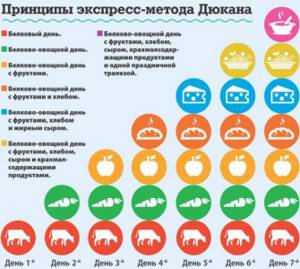
Only products of brain ripeness are suitable for preservation, therefore canned food is strictly prohibited according to the Dukan method, and green peas are allowed in quantities acceptable for vegetables.
Diet Favorite
In the Favorite diet, there are drinking, protein, fruit and vegetable days. Consumption of canned and green peas is acceptable on vegetable days. Legumes will not only quench your appetite, but also compensate for the lack of vitamins in the body.
7 day diet
Pea greens have been successfully used as the basis for many types of diets due to their low calorie content and high content of vitamins and minerals. A pea diet for a week will help you lose 10 kg without feeling debilitating hunger. Meals are served in small portions.
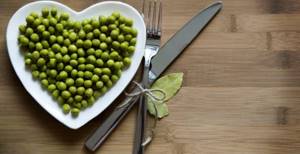
Green peas are good for diets; they are the key to good health.
Sample menu:
- breakfast - Hercules poured with boiling water with a whole or mashed apple;
- lunch - mashed potatoes, apple or vegetable stew with peas;
- dinner - 200 g of canned peas, fish steak or a piece of boiled chicken breast.
Harm and contraindications for use
Absolute contraindications to the use of the product are observed in the following cases:
- Flatulence.
- Gout.
- Digestive disorders.
It causes intestinal irritation if a person has problems with the gastrointestinal tract. If a diagnosis of gout is made, then eating it is strictly prohibited. He will do harm. The product contains a large amount of protein. This is useful for people who do not have this pathology. But purine compounds will have adverse effects on a person with gout. In 100 gr. bean, the amount of purine compounds is 64 mg - this is approximately 150 mg of uric acid. Its excess in the human body leads to this disease.
It is not recommended to eat peas if you have nephritis. This is explained by the fact that during the processing of food, nitrogenous wastes are formed from protein. They are excreted through the kidneys. If this paired organ is in an inflamed state, the process becomes much more complicated. Toxins that are not removed by them accumulate in the human blood over time.
You cannot completely stop eating protein. It is an important element in the body. Doctors prescribe a special diet for patients, which is aimed at consuming protein in small doses. Per day – approximately 20 grams.
Diet recipes
Dietary peas go well with fresh, crispy vegetables, aromatic herbs and various cereals.
Omelet with green peas
For a tender and fluffy omelette you will need a minimum of ingredients.
Required components:
- 200 g peas;
- 3 eggs;
- a pinch of freshly crushed black pepper;
- a pinch of crushed salt;
- 3 tbsp. l. refined oil;
- 3 pieces of lean chicken ham;
- a handful of chopped dill or parsley.
Step by step cooking method:
- The peas are lightly boiled. Eggs are cracked with salt, pepper and 3 tbsp. l. water.
- 3 omelette pieces are fried in a frying pan on a frying surface greased with vegetable oil.
- Omelette pancakes are sprinkled with peas, placed in a frying pan and heated for 3 minutes.
- The dish is laid out on plates, with a piece of ham and a handful of herbs placed on top.
The treat is served in the morning with a glass of tomato juice and a slice of toasted rye bread.
Salad with boiled corn
A fresh and tasty salad is perfect for a snack.
You will need:
- 1 large sweet and sour apple;
- 2 tbsp. l. lemon juice;
- a bunch of crispy green onions;
- a glass of green peas;
- a glass of corn kernels;
- 200 ml low-fat Greek yogurt;
- 1 tsp. curry powder;
- a pinch of freshly crushed pepper and salt;
- 100 g bacon.
Step-by-step method for preparing the salad:
- The apples are peeled, the core is cut out, and the pulp is cut into bars.

- The pulp is sprinkled with lemon juice.
- The onion is chopped and mixed with peas, apples and boiled corn kernels.
- Salt and spices are added to the yogurt, the bacon is chopped and added to the salad.
- Mix everything so that the sauce soaks the vegetables well.
The salad is served immediately after preparation, decorated with a slice of lemon and olives to taste.
Criterias of choice
If it is impossible to make it yourself, you need to be able to choose correctly which company’s products are better and where to buy budget canned food. A wide range does not always allow you to find the required product with maximum benefit. This material will tell you what to pay attention to so as not to make mistakes when choosing. First of all, you need to look not at the cost, but at compliance with the interstate standard (GOST) and the All-Russian Product Classification (OKPD), as well as the following:
- The shelf life in metal cans is no more than two years, in glass containers - no more than three years, in metal cans with an enamel interior - no more than four years.
- Preservation should be carried out in May or June from young raw materials. In other months, the product is usually made from frozen or dry peas.
- The traditional composition should include only peas, water, sugar and salt.
- A quality product must bear the GOST 34112-2017 marking (the old GOST R 54050-2010 is no longer valid as of January 1, 2019).
- On the lid of the jar, a description of the date of manufacture is applied with indelible paint. On older equipment that produces lower quality products, the date is extruded.
- There should be no dents on the tin can, so as not to provoke oxidation processes with the release of toxins.
- The liquid in a glass container should not be cloudy. There may be a slight sediment of starch.
- The feeling of a sour smell after opening the can indicates spoilage of the canned food.

Recipes for everyday menu
Nutritious and tasty dishes are served both for breakfast and as a full, satisfying snack.
Potatoes with sour cream
This moderately spicy and appetizing dish will appeal to all family members.
Product set:
- ½ kg potatoes;
- a pair of onion heads;
- 300 g green peas;
- 1 tbsp. l. melted butter;
- a glass of chicken broth;
- 3 tbsp. l. fat sour cream;
- salt and ground pepper - as needed;
- chervil leaves.

Cooking process in stages:
- Boil the potato tubers in their skins, adding salt at the end.
- The onion is chopped and fried in oil, peas are poured into it and broth is poured.
- The workpiece is boiled for 15 minutes after boiling.
- The chervil is laid out, after which the soup is blended with a blender to the consistency of puree.
- Peeled potatoes are chopped into pieces and poured over the pureed soup.
When serving, the dish is decorated with a spoonful of sour cream and chopped herbs.
Schnitzel
A hearty meat dish with peas suitable for a gala lunch or dinner.
Food set for cooking :
- a pair of onions;
- 3 pieces of veal;
- 1 tbsp. l. refined oil;
- 500 g of fresh peas;
- 1 cup strong chicken broth;
- 3-4 tbsp. l. milk;
- 1 tbsp. l. flour;
- 1 tbsp. l. pickled horseradish;
- 4-5 chopped parsley branches;
- 4-5 tbsp. l. frying oils;
- a pinch of crushed salt and pepper crushed in a mortar.
Step by step cooking process:
- The onion is chopped and fried in butter. Add peas and broth and simmer for 15 minutes.
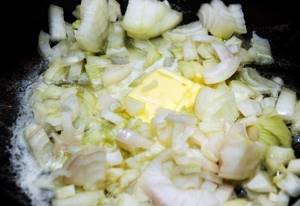
- Flour is poured into the milk, horseradish is added and the whole mass is transferred to the peas. The mixture is boiled and seasoned with salt and pepper.
- At the end, the sauce is sprinkled with parsley, boiled and set aside.
- Schnitzels are salted and peppered to taste, rolled in breadcrumbs and fried in oil.
Serve on a flat plate. The meat is laid out, generously poured with sauce and decorated with chopped herbs.
How to use
Canned peas can be served as a separate dish with the addition of melted butter, sauce, mayonnaise or sour cream. In addition, it is used as a decoration in appetizers or cold dishes, and also for adding to:
- first meal;
- meat, fish or vegetable salads;
- the vinaigrette;
- casseroles, omelettes;
- pates, stews;
- sauces.
When preparing first courses, you can add filling along with peas to enrich the taste and saturate them with useful substances.

Dishes made from young raw peas
Juicy peas go great with vegetables, veggies and pasta.
Summer pasta
A mouth-watering dish with hearty pasta and the freshness of peas complemented by the creaminess of cheese and spices.
Required set of products:
- 200 g peas;
- onion head;
- 2 cloves of garlic;
- young zucchini without coarse seeds;
- a handful of asparagus;
- a bunch of spinach greens;
- ½ cup cream;
- 100 g creamy hard cheese;
- boiled pasta;
- 3 tbsp. l. refined oil.
Cooking food step by step:
- Fry chopped onion and garlic in oil for 2 minutes.
- Add peas, sliced zucchini, blanched spinach and peeled asparagus.
- The components are stewed until soft, cream is added.
- The mixture is simmered for 5 minutes, covered with grated cheese.

The sauce is spread over boiled pasta and served hot with vegetables and a glass of white wine.
Risotto
Delicious and nutritious, risotto with bacon and peas is not a classic dish, but its taste is soft, velvety and delicate.
Required list of products:
- 200 g smoked bacon;
- onion head;
- 300 g round rice for risotto;
- 3 tbsp. l. dry white wine;
- 1 liter of broth;
- a glass of peas;
- 1 tbsp. l. natural yogurt;
- 1 tbsp. l. grated cheese shavings;
- a piece of butter;
- a pinch of finely chopped salt.
Cooking method step by step:
- Sliced bacon with chopped onion is fried in butter until golden.
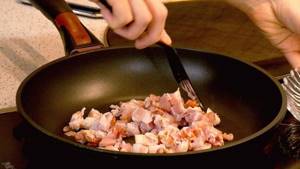
- Rice is poured in, wine and broth are poured.
- The components are mixed.
- The peas are laid out, after which the dish is simmered until it is soft.
- Add pepper, salt and any other seasonings to taste, add cheese, after which the mixture is seasoned with yogurt.
The risotto steeps for 3-5 minutes and is served.
comparison table
| Brand | Weight, g | Peas weight, g | En. value, g | Proteins, g | Carbohydrates, g | Fats, g | price, rub. |
| Green Ray | 420 | 252 | 38.4 | 3.1 | 6.5 | 0 | 75-85 |
| Uncle Ivan | 400 | 240 | 35 | 3.1 | 6.5 | 0 | 100 |
| ECO | 400 | 240 | 38.4 | 3.1 | 6.5 | 0 | 69 |
| Heinz | 390 | 250 | 70 | 4 | 11.11 | 0.3 | 60-90 |
| Lutik | 425 | 240 | 38.4 | 3.1 | 6.4 | 0 | 66 |
| Frau Martha | 310 | 186 | 35 | 3 | 6 | 0 | 66 |
| Mikado | 400 | 240 | 38.4 | 3.1 | 6.5 | 0 | 66 |
| Bonduelle | 400 | 265 | 74 | 5.5 | 7.4 | 0.7 | 80-111 |
| Glavproduct | 400 | 240 | 38.4 | 3.1 | 6.5 | 0 | 108 |
| 6 acres | 400 | 260 | 38.4 | 3.1 | 6.5 | 0 | 52-100 |
Thus, the brands presented in the rating have very similar values of the main indicators and properties with the classic composition of canning. However, some points can be highlighted:
- Frau Martha has the smallest jar - only 310 grams;
- Bonduelle and Heinz – the highest energy values due to the increased content of carbohydrates and the presence of fats;
- Bonduelle, Glavprodukt and Uncle Vanya have the highest price indicators in the retail chain.
Dishes with sprouts
Green peas, which are quite low in calories, are most useful when sprouted.
Hummus
The thick and aromatic mass serves as an excellent addition to toasted toast and as a filling for sandwich tartlets.
Need to:
- sprouted peas – 300 g;
- zucchini – 150 g;
- a couple of cloves of garlic;
- lemon juice – 2 tbsp. l.;
- aromatic olive oil – 2 tbsp. l.;
- 1 tbsp. l. sesame seeds;
- 1 tsp. salt;
- 2 tbsp. l. chopped parsley.
Step by step cooking method:
- All ingredients are placed in a blender bowl and blended into a paste.
- The mixture is seasoned with salt and sprinkled with chopped parsley and sesame seeds.
The dish is eaten with unleavened flatbread, pita bread and vegetables.
Warm salad
A nutritious, fresh and aromatic salad with meat and vegetables is sure to please all family members due to its mild taste, combination of aromas and textures.
Required:
- 100 g of sprouted peas;
- fleshy tomato;
- bright thick-walled pepper;
- Crimean red onion;
- 1 tbsp. l. aromatic olive oil and soy sauce;
- grilled chicken breast.
Step-by-step cooking method:
- Pour boiling water over the peas and leave for 10 minutes.
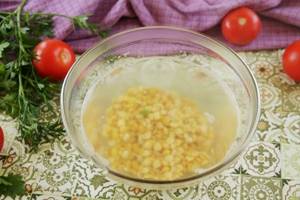
- The pepper, tomato and onion are chopped into cubes, and all the products are laid out in a salad bowl.
- The ingredients are seasoned with sauce and butter.
Place chicken breast cut into strips on top of the salad.
Where can I buy
Shop windows and supermarket shelves are filled with a wide range of canned green peas of various brands. Often, a large number of products confuses the buyer, which does not allow him to choose the best quality, but not very expensive option, which one is better to buy.
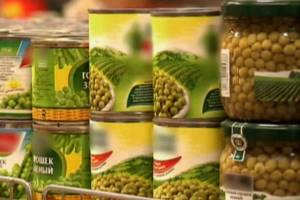
In addition, you can now order online from the online store of a manufacturer or supplier of canned foods, the list of which necessarily contains green peas.
Canned pea dishes
Canned green peas have a high calorie content, but the vegetable is excellent for preparing tasty and nutritious dishes.
Light salad
Cooking does not require expensive products; an egg is added to the recipe if desired, and the dressing is made from olive oil.
Product set:
- fresh carrots;
- 3 tbsp. l. canned peas;
- 200 g cabbage;
- egg;
- a pinch of fine salt;
- a little olive oil.
Cooking diagram step by step:
- The egg is boiled and peeled.
- The cabbage is chopped into small strips.
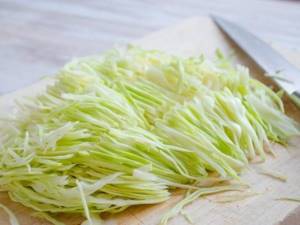
- Grate the carrots along with the egg.
- All products are crushed and mixed with peas.
- The products are combined, salted and seasoned with oil.
The salad is served with bread croutons, wine and green olives.
Canned soup
This light soup with a velvety texture can be eaten in the evening without harming your figure.
Required:
- a couple of tomatoes;
- bright sweet pepper;
- a couple of carrots;
- 500 g peas;
- sweet onion;
- zucchini;
- piece of cabbage 300 g.
Cooking process:
- The water is boiling. Onions are cut into half rings, tomatoes and zucchini into slices, and cabbage and pepper into strips.
- The carrots are grated. Vegetables and peas are placed in boiling water and boiled.
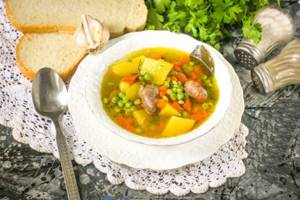
The dish is seasoned with salt and spices, pureed if desired and served with cream.
Canning at home
Popular models of industrial production do not exclude the use of additional preservatives or food additives, which do not have the best effect on the properties of the product. Therefore, preparing products with your own hands at home cannot be compared with samples from the store.

Now there is no problem finding recipes for making canned food. There is a lot of advice online, including step-by-step instructions on how to can.
Green peas of the brain or smooth-grain variety for canning are bought at the market or grown in the garden. After husking, the kernels are thoroughly washed and poured with salted water to boil for four to six minutes. Then the liquid is drained, and the peas are washed again and placed in sterilized glass jars with a volume of no more than half a liter.
When ready, add salted boiling water in the proportion to one liter of water, one tablespoon of salt with the addition of sugar, as well as vinegar essence. The process is completed by rolling up the lids and then cooling at room temperature. Finished products are stored in the refrigerator or cellar.
Ice cream pea dishes
Green peas (the calorie content of a frozen product is equal to the calorie content of a fresh product) goes well with fish and seafood.
With octopuses
Tender octopus flesh, vegetables and peas are combined in a mouth-watering dish. During the frying process, the tentacles curl beautifully, making the salad brighter and more elegant.
Necessary:
- 700 g octopus;
- 3 small onion heads;
- carrot;
- 200 g frozen peas;
- a couple of cloves of garlic;
- 2 tbsp. l. tomato paste and soft butter;
- a glass of white wine;
- 1 tbsp. l. Worcestershire sauce;
- a pinch of dried Provençal herbs.
Cooking takes place in steps:
- The carrots are grated, the onions are chopped into half rings, the garlic is chopped into smaller pieces.
- The octopuses are cleaned and washed.
- Garlic and onions are fried in oil, octopus is laid out with Worcestershire sauce, carrots, pasta and wine.
- The dish is stewed for 30 minutes, peas, salt and seasonings are added.
After half an hour, the treat is ready to be served with pomegranate seeds, slices of lemon or olives.
Fish balls
The pulp of cod and pink salmon is mixed, resulting in tender, moderately fatty minced meat, from which soft meatballs are prepared.
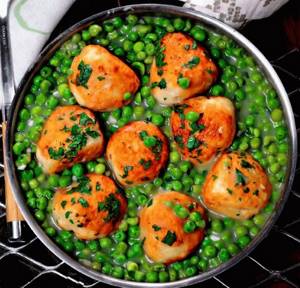
Required:
- 300 g minced cod with pink salmon;
- a piece of ginger the size of a walnut;
- a bunch of onion greens;
- 1 teaspoon starch;
- carrot;
- 2 porcini mushrooms;
- bulb;
- sweet pepper;
- frozen green peas – 200 g;
- rice noodles - optional;
- 3 tbsp. l. soy sauce;
- 3 tbsp. l. refined oil;
- a handful of rice flour - for breading;
- fine salt and crushed black pepper to taste.
Cooking method:
- Chop the green onions and grate the ginger.
- Place half of the ginger in the minced meat, pour in 1 tbsp. l. soy sauce and starch. Stir the mass.
- Form meatballs, bread in flour and fry in oil.
- Peel the vegetables, cut the onion lengthwise, the carrots into half rings, and the pepper into strips.
- Heat the ginger in oil, and fry the chopped mushrooms with carrots, peas, onions and peppers.
- Boil the noodles and mix them with vegetables. Place the meatballs in a dish, add soy sauce and simmer for 4 minutes.
Serve this delicious treat chilled.
How to save peas for the winter
High-quality fresh peas are bright green in appearance, dry with a stalk. The fresh product is stored on the bottom shelf of the refrigerator in a bag for no more than 12 days.
Freezing
Not only pods can be frozen, but also peeled beans of the “snow” and “sugar” varieties. Before freezing, the pods are carefully inspected to ensure there is no damage to the surface, washed, removed from the edges and blanched in boiling water for 2 minutes.
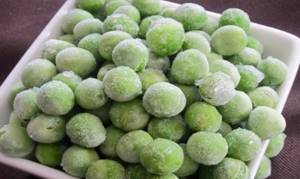
Afterwards, the pods are immersed in cold water and after 5 minutes they are placed in the freezer. You can also pour water into ice molds, leave for 12 hours, shake out of the molds and put them in a bag.
Canning
Green peas (canned beans have a higher calorie content due to the use of spices) are most often stored in jars.
Canning process:
- The pods are peeled and boiled in salted water for 4-5 minutes.
- The raw materials are distributed into half-liter sterile jars.
- Prepare brine at the rate of 1 tbsp. l. salt, the same amount of sugar and vinegar per 1 liter of water.
- The jars are filled with brine and sealed with tin lids.
Appetizing and juicy peas are used to make salads, pies, casseroles and soups.
Harmful effects
Along with the positive effect on the body, such a harmless product has dangerous properties.
- Contraindications for use in gout and urolithiasis due to the purine content.
- Use is not recommended for diseases of the gastrointestinal tract and flatulence.
- Caution in small doses for diabetics due to increased sugar content.
- Individual intolerance cannot be excluded.
Not recommended for elderly people leading a sedentary lifestyle due to the possible development of bloating or flatulence!

Use in folk medicine
Numerous traditional medicine recipes include peas. Decoctions, ointments, tinctures and compresses are made from it.
For example:
- For heartburn you need to eat 2-3 peas soaked in boiling water.
- A 2-week pea diet of steamed porridge and puree helps with splenic cysts.
- Canned vegetables help with constipation.
- 5 g of pea flour before meals 4 times a day normalizes brain function and relieves headaches.
- Shoots boiled for 10 minutes, infused and strained help with urolithiasis. The decoction is drunk 40 ml 4 times a day.
- With furunculosis, 2 tbsp are combined. l. grind peas into flour with water to a paste. The mixture is applied to a bandage and applied to the sore spot for 2 hours.
How to use
Tips and recommendations for eating peas can help you stay healthy.
- Three to four times a week, eat no more than 150 grams per day.
- Avoid consumption in the afternoon and evening due to possible gas formation in the intestines.
- Do not combine with bread, potatoes, cereals, or sweet desserts.
- Do not keep it in an open container for more than a day.
- Do not drink it with tea, but rather pour it from a jar due to the high content of vitamins.
- When used for salads, the filling is drained.
How to choose the right product?
Green peas are harvested when they reach “milk” maturity so that the kernels do not lose their juiciness. The stalks should remain fresh and the peas should be bright and not wet. It is important to check for dark spots and obvious damage. Canned peas are more difficult to choose.
Package
Most often, canned food is found in tin cans. When purchasing, pay attention to the condition of the packaging. You should not purchase rusty or damaged cans, as chipped pieces of enamel may remain inside.
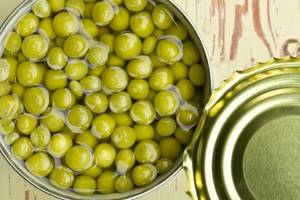
When interacting with metal, oxidation occurs, which negatively affects the quality of the product.
It is much easier to assess the condition of peas in a glass jar. The lid on the container should not be swollen. This fact indicates product damage.
Label
The best peas are marked “GOST” or “GOST 15842-90”, and the jar says “extra” or “highest grade”. The ideal composition indicated on the package: fresh peas, water, sugar, salt. Sometimes the recipe specifies the hardener calcium chloride. It negatively affects the taste of canned food.
Product type
The taste of ready-made dishes and canned food depends on the type of product:
- Mozgovoy is the highest grade. After boiling, the peas become brighter and greener.
- Sugar - not subject to heat treatment.
- Smooth grain – less sweet, after boiling it acquires a gray-green tint.
Important! If the peas are made by fox or fall, it means that dried raw materials were used.
This product will retain all the beneficial substances, but the taste will be starchy.
Weight
Often, recipes do not indicate the required weight of peas, but instead indicate a “can.” Finding out the amount of pure product without container weight and marinade volume is quite simple. For example, in a tin can of 400 ml of pure product there will be 250 g. According to the formula, the volume of the container is divided by 2-2.2.
Composition and nutritional value
Green peas have many beneficial properties due to their unique composition. It is rich in easily digestible proteins and carbohydrates and low in fat and cholesterol.
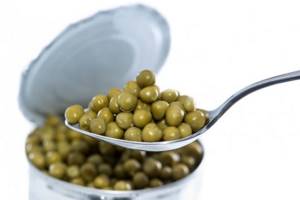
Canned green peas are a jellied food product processed by pasteurization or sterilization without additional preservatives.
As a rule, the composition contains:
- the main product is peas;
- sugar;
- salt;
- water.
The usefulness is determined by the list of minerals (26 in total, including iron, potassium, chlorine, iodine, etc.) and vitamins:
- beta-carotene;
- group B (except B12);
- E, N, K, RR.
Preservation of nutrients is ensured by gentle processing.
The glycemic index value of 35-48 units allows for limited consumption by diabetics. Low calorie content makes the models popular among those losing weight.

Classic food (energy) value of canned food per 100 grams:
- proteins – 3.6 g (14.4 kcal);
- carbohydrates – 9.8 g (39.2 kcal);
- fats – 0.1 g (0.9 kcal).
Interesting facts about green peas
Green peas are an interesting vegetable that has a rich history.
For example:
- Sown peas reach 2 m in height.
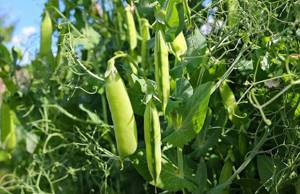
- More than 15,000,000 tons of product are collected annually in the world.
- The word "peas" means "grated" because they were originally ground into flour.
- Initially, peas were consumed in ripe form, and green only from the 17th century.
- Pea sausage was an everyday food product for German soldiers in the 19th and 20th centuries.
- Most of the crop is grown in China, Russia and Canada.
Green peas are a unique vegetable that is used in cooking, dietetics and cosmetology. The calorie content of the product is quite low, so it is used in diets as side dishes and soups.
It is best to consume peas fresh to maximize the benefits of the product. The rich vitamin and mineral composition protects the body from chronic diseases, improves digestion and stimulates weight loss.
Article design: Anna Vinnitskaya

